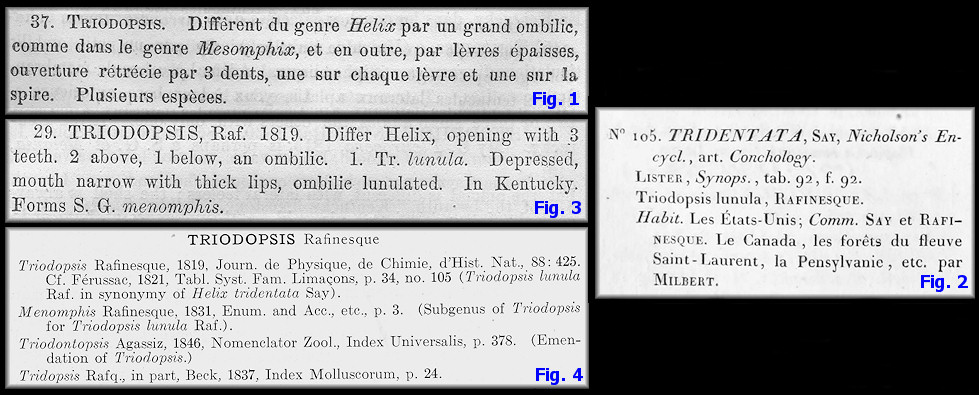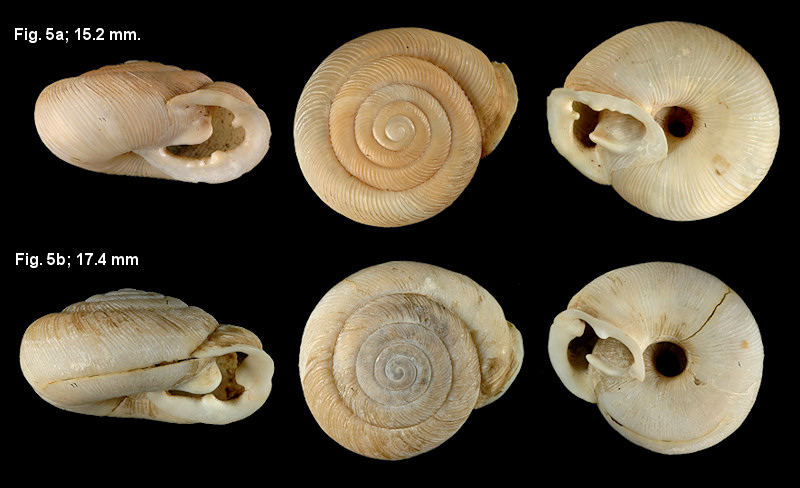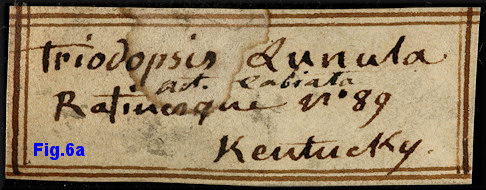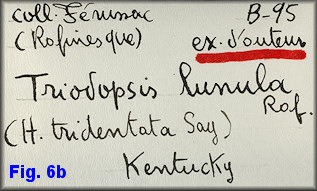|
Threetooth ID ruminations open a centuries-old amphi-Atlantic Pandora’s Box |
|
by Harry G. Lee |
|
The genus Triodopsis Rafinesque, 1819: 425 [Type Species: T. lunula Rafinesque, 1831 (= Helix tridentata Say, 1817) Rafinesque, 1831 fide Férussac, 1821]* as currently interpreted (Emberton, 1988) is widely distributed in eastern North America, particularly the southeastern US. The conchological identification of the slightly less than thirty species of these so-called “Threetooths” is based on apertural dentition, tightness of coil, umbilical diameter, axial sculpture, pigmentation of fresh material, and zoogeography (see The Genus Triodopsis). That may seem simple enough, but other factors add a degree of difficulty possibly unique to this genus. There is convincing evidence of hybridization among species, and, consequent in part to the ability of some taxa to prosper in human-altered environments, numerous anthropogenic introductions have confused what was certainly a more orderly zoogeographic mosaic before the European immigration. Furthermore, significant intraspecific variation, evident even within a single population, may add complexity. On the other hand, last year Bill Frank and I had created a simple compendium of single images of each of the twenty-eight generally-recognized species of Threetooths (cited above), so I thought identification of four living Threetooths taken by Jacksonville Shell Club (JSC) member Billie Brown in Thomaston, GA would be greatly facilitated. Hours later, I realized that “greatly” was a bit a generous for a description of the ultimate campaign. For openers, these snails didn’t quite match anything in the website portfolio! After ransacking my library, I found a much better match - essentially perfect: paratypes of T. affinis Hubricht, 1954** figured by Grimm (1975: fig 2D). Almost satisfied, I then delved a little deeper and found that Hubricht (1954: 28-30) stated “the only difference between T. messana Hubricht and T. f. affinis is in the color.” As unusual as this dependence on shell coloration struck me, Grimm (1975) seemed to have been in agreement. Next, the original descriptions were consulted. Hubricht (1952: 80-81) characterized T. messana as “reddish brown” [later “dark red-brown to walnut brown” by Grimm (1975)], the largest in his cited type series (five) was 15.0 mm in maximum diameter, and he remarked on the variability of the outer lip tooth, in some “pointed and little if any inflected; in others broadly rounded and deep-seated.” He cited Pilsbry (1940: 810: fig. 480 C) but did not otherwise figure this species. In his description of T. fallax affinis (Hubricht, 1954) he used “deep olive buff to wood brown” to describe the shell, the largest of his cited type series (five) was 13.3 mm, and no figure was provided. Both the latter taxa are anthropochorous, meaning able to live in human-altered environments (Hubricht, 1952, 1954, 1971, 1984, 1985; Grimm, 1975), which is consistent with the habitat in which Billie collected her snails; both potentially occur in Upson Co., GA (Hubricht, 1985), where the topical specimens were found, and neither seems to have an authentic figure other than those cited, all graytones. On the one hand, her shells match T. affinis more than they do T. messana based on figures in Pilsbry (1940: fig 480 c) and Grimm (1975; figs. 1E, 1F, 2D) in having a more laterally-expanded aperture and a tighter coil. However, (1) shell color, definitely red brown and darker than the tones indicated for T. affinis, (2) size (from 13.3 to 14.7 mm; three of them over 14.0 mm), (3) outer lip tooth variability (strikingly evident in these four shells), and (4) Hubricht’s (1954) remark about the remarkable similarity between the two taxa, impel me to conclude that Billie’s shells are better referred to T. messana. I feel reasonably confident, based on years of observing variability in this genus, that this is a true instance where a taxonomic determination is better made relying on the salients in the written description than with primary reliance on (authentic) illustration(s). The several images provided with this report are intended to add a dimension to the identity of Triodopsis messana,*** a valid biospecies with a confusing assortment of characters, some variable and others constant. |
|
*This phrase merits elaboration. Although Rafinesque (1819: 425; my Fig. 1 above) gave an adequate description of the genus and mentioned “plusieurs espèces,” he cited none by name. Andre Étienne Just Pascal Joseph François d’Audebard, Baron de Férussac (1786-1836) was in correspondence with Rafinesque, who apparently sent material to him in Paris. He introduced Rafinesque’s manuscript name, Triodopsis lunula, in the synonymy of Helix tridentata Say, 1817 (Férussac, 1821: 34, species 105; my Fig. 2). Presently T. lunula Férussac is treated as an unavailable name. A relevant provision in the Code (ICZN, 1999) is Article 11.6 Publication as a Synonym, which reads: “A name which when first published in an available work was treated as a junior synonym of a name then used as valid is not thereby made available.” One relevant exception immediately follows (11.6.1): “However, if such a name published as a junior synonym had been treated before 1961 as an available name and either adopted as the name of a taxon or treated as a senior homonym, it is made available thereby but dates from its first publication as a synonym.” Although Rafinesque’s (1831; Fig. 3) usage is iffy since he didn’t cite Férussac, to date it appears that no one, including Pilsbry (1930: 322-323; Pilsbry, 1940: 790: my Fig. 4 above) seems to have “adopted” (treated as valid) T. lunula Férussac, 1821 “as the name of a taxon.” The reference to Helix tridentata Say as a synonym is not treatment as valid. Further, no author has ever produced an indication for T. lunula other than this synonymy, and authorities would probably regard the binomen as a nude name and thus unavailable for taxonomic nomenclature. Also without description, the Baron cited other (Rafinesque manuscript) names as belonging in Triodopsis, e.g., T. clausa Raf. and T. scabra Raf., but he did not indicate a type for the genus. In fact he considered them all to belong to his Helix (Helicodonta), now considered to be an Old World species-group. The type of Triodopsis was designated by its original author twelve years after its introduction: Triodopsis lunula Rafinesque, 1831 (my Fig 3, above) in a rarely-witnessed nomenclatorial act, “subsequent monotypy.” The appearance that Rafinesque never gave consideration to the nominal taxon Helix tridentata Say is misleading. Quite possibly it resulted from a nomenclatorial convention of the day, and utilized frequently in his opera, of replacing the species epithet when a taxon was reassigned from its original genus. He was certainly aware of Say (1817) as he often cited it in his other works, and he may have thought it to be synonymous with his T. lunula. Since there was apparently no relevant name-bearing Rafinesque specimen ever presented in the literature (e.g., Pilsbry, 1930: 322-323; Pilsbry, 1940: 790-797), an inquiry was placed on 10 November, 2010 at the Muséum National d’Histoire Naturelle, Paris (MNHN), the repository of much of the Baron’s collection (Sherborn, 1940: 51). It seemed to me that should the shell(s) he called “Triodopsis lunula Raf.” belong a species other than T. tridentata (Say, 1817) (i.e., what if the Baron’s synonymy was incorrect?) another chapter in this byzantine chronicle might be necessitated.
Mirabile dictu; not too long afterward, Virginie Héros MNHN Chargée de Conservation, Collection Mollusques, located two shells (Figs, 5a, 5b) belonging to Férussac and labeled Triodopsis lunula Rafinesque, the earlier of the two labels probably in the Baron’s hand (Figs. 6a, 6b below). There are two important discoveries here: (1) This two-specimen lot is comprised of different species: 5a: Triodopsis tridentata (Say, 1817) and 5b: T. vulgata (Pilsbry, 1940). (2) The specimens almost certainly originated with Rafinesque. At the time Rafinesque likely sent the shells to the Baron (ca. 1820), he was in north-central Kentucky, and it was likely here that he collected 5b. The label appears to read “at. labiata.” Does this mean “at[que] [forma] labiata?” indicating Rafinesque knowingly included a second form, likely collected in Kentucky, in this lot? We’ll probably never know. Nonetheless, since the genus Triodopsis is based on this lot, it seems prudent to declare that this shell, not 5b, belongs to the species that authors have come to regard as the type of Triodopsis Rafinesque, 1831. In other words, we’re cutting the Baron some slack on his synonymy and preventing potential fall-out which would destabilize the taxonomy and nomenclature of the group. Although Say’s description and figure are inadequate to define T. tridentata, and he apparently left no type material, Pilsbry (1940: 796; Fig. 474a) removed any doubt as to its identity by designating a neotype from SE Pennsylvania in the collection of the Academy of Natural Sciences, Philadelphia (ANSP). |
|
|
|
|
|
** Regarded
by certain authorities as a stable hybrid between T. fallax
and T. alabamensis and not recognized by Turgeon Quinn et al.
(1998: 153). *** Misleadingly dubbed the “Pinhole Threetooth,” apparently based on the relative size of the umbilicus as seen in the type figure. Nonetheless, this is one of those variable characters to which reference is made in the text above. The author is indebted to Billie Brown for her unflagging attention to landsnails during her many peregrinations, to Philippe Bouchet (MNHN), Dick Petit (North Myrtle Beach, SC), and Gary Rosenberg (ANSP) for enlightening discussions related to the taxonomic and nomenclatorial quirks involved in this probe. Virginie Héros and Philippe Maestrati (MNHN) provided vital curatorial and photographic contributions (respectively), and Bill Frank (Jacksonville) gave technical assistance in several aspects of the preparation of this report. |
|
|
Literature cited:
Binney, W.G. and G.W. Tryon, Jr. [eds.], 1864. The complete
writings of Constantine Smaltz [sic] Rafinesque on Recent and
fossil conchology. 1-96 +7 + pls. LXX-LXXII. Bailliere Bros.,
New York. (On-line) |
|



